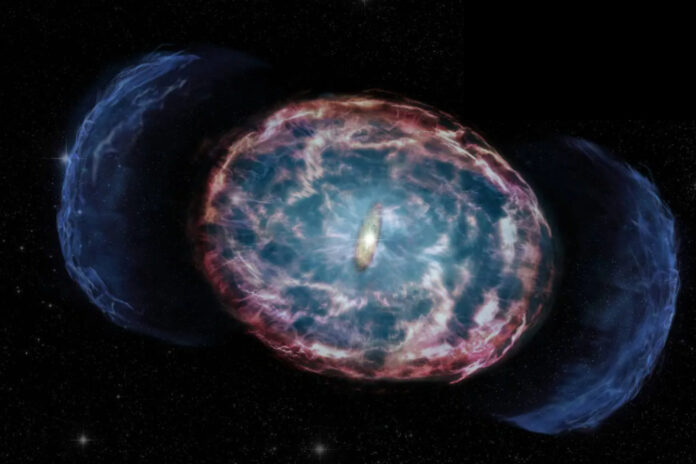Being too close to two neutron stars colliding spectacularly may be catastrophic for a planet like Earth, scientists have calculated.
This type of cosmic event is known as a kilonova and releases huge amounts of energy in the form of electromagnetic radiation and cosmic rays.
If Earth happened to be in the firing line of a beam of this intense radiation, it could wreak destruction to life on our planet, according to a new paper in The Astrophysical Journal. However, we would have to be quite close to a kilonova for life to be endangered, with the safety distance varying based on the type of radiation that hits us.
NASA/CXC/M.Weiss
“Binary neutron star mergers produce high-energy emissions from several physically different sources, including a gamma-ray burst (GRB) and its afterglow, a kilonova (KN), and, at late times, a remnant many parsecs in size. Ionizing radiation from these sources can be dangerous for life on Earth-like planets when located too close,” the authors wrote in the paper.
Kilonovas are huge explosions, larger than supernovas, triggered when either two neutron stars or a neutron star and a black hole collide. They release high-energy gamma rays, which are dangerous in and of themselves, but these gamma rays may also collide with and heat up cosmic gas and dust, producing a powerful X-ray afterglow. These X-rays could also pose a risk to life on Earth. Kilonovas also send out shockwaves known as remnants, which can result in cosmic rays being emitted from gas and dust in the firing line of the shockwave.
All three of these types of radiation are dangerous, with the X-rays and gamma-rays ionizing our atmosphere and leaving us vulnerable to solar winds and ultraviolet light from the sun, and cosmic rays possibly vaporizing the atmosphere and causing widespread extinctions.
“If sufficiently close, the brief [gamma-ray] cocoon emission would ionize the atmosphere, causing a hemisphere-wide EM [electromagnetic] pulse. Additionally, astronauts on the ISS or the Moon would be irradiated by the gamma rays and cosmic rays with no protection from the atmosphere. The cosmic rays would cause astronauts to experience flashes of light while their eyes are closed, as was experienced by Apollo astronauts,” the authors wrote in the paper. “For those on Earth, the muons produced in the atmosphere would be difficult to avoid, and they have been found to cause mutations and birth defects”
The particular kilonova looked at in the study is known as GW170817, situated around 130 million light-years away from Earth, which was first observed in 2017 after gravitational waves were spotted rippling out from two colliding neutron stars, sending ripples through spacetime. The optical and gravitational data gathered allowed scientists to calculate the potential energy released by this kilonova, and calculate the minimum distance that we would have to be from a kilonova to be safe.
The researchers found that a kilonova would have to be within 3 light-years of Earth to be affected by the X-ray afterglow, and within 13 light-years for the gamma-rays to have a catastrophic impact. The effects of the cosmic rays spread even further and would be dangerous up to a distance of 36 light years away.

However, luckily for us, it is very unlikely that a kilonova will occur within these distances from us any time soon.
“Gamma ray bursts are flashes of high energy radiation that come from astrophysical sources scattered throughout the universe. The flashes are often very brief, usually lasting from a fraction of a second to minutes. These flashes are not directly visible from the surface of the Earth—the radiation is absorbed by the atmosphere,” Andrew Klekociuk, an atmospheric scientist at the Antarctic Climate Program, told Newsweek.
“They have rarely occurred over the history of the Earth. This is probably why we are here, as a nearby event could be detrimental to life by causing a sudden change in the protection afforded by the ozone layer.”
“The rarity of BNS [binary neutron star] mergers combined with a small range of lethality means that they are probably not important threats to life on Earth. We find that the mean recurrence time of lethal mergers at the location of the Sun is much larger than the age of the Universe,” the authors wrote in the paper.
If one were to occur outside of these distances but still quite close, it could still have impacts on the Earth and our civilization.
“However, even if it never induced a mass extinction, a nearby KN [kilonova] event would be visible on Earth. It would likely disrupt technology soon after the merger and remain bright in the sky for over a month,” the authors wrote.
Areas of the galaxy that are more likely to see neutron star mergers that lead to kilonovas may have chances of life developing scuppered by the powerful radiation released. However, this is also unlikely, with other cosmic events like supernovas being more of a risk.
“We conclude that mergers viewed off-axis are unlikely to ever impact life on Earth in any significant way, and they are also unlikely to disrupt potential life in other parts of the Milky Way,” the authors wrote. “[Previous research] describes four components of the Galaxy, and the two that are most likely to contain BNS merger progenitors, the halo and thick disk, are too metal-poor to harbor planets with life. We note also that if there were to be life in the Galactic bulge, which harbors the highest concentration of stars, SNe [supernovas] are the main threat.”
Do you have a tip on a science story that Newsweek should be covering? Do you have a question about kilonovas? Let us know via [email protected].
Uncommon Knowledge
Newsweek is committed to challenging conventional wisdom and finding connections in the search for common ground.
Newsweek is committed to challenging conventional wisdom and finding connections in the search for common ground.


